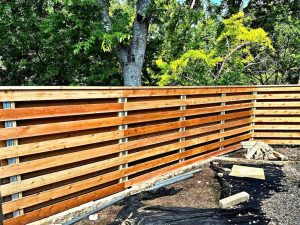TL;DR
Fence disputes in Austin usually involve property line misunderstandings, shared maintenance costs, or unauthorized fence construction. Texas law encourages neighbor communication and documentation first, followed by mediation or small claims court if unresolved. Before taking legal action, confirm the exact property line, gather evidence, and consult a licensed fencing professional. A code-compliant fence from Austin Fence Contractor ensures peace of mind and lasting neighborly relations.
Why Fence Disputes Happen in Austin
 In a growing city like Austin, where property boundaries often sit close together, fence disputes are one of the most common neighborhood conflicts. These issues can arise from:
In a growing city like Austin, where property boundaries often sit close together, fence disputes are one of the most common neighborhood conflicts. These issues can arise from:
- Confusion about property lines
- Shared maintenance disagreements
- Unapproved fence installations
- Encroachments onto another property
- HOA or city code violations
Even minor misunderstandings can turn into legal headaches if not handled early and professionally.
Fences are meant to provide privacy and protection — not conflict. That’s why it’s critical to know your rights, responsibilities, and local laws before making any changes.
Understanding Property Line Laws in Texas
Under Texas property law, fences are typically considered boundary markers, but ownership and maintenance depend on where the fence is located.
Here’s how it generally works in Austin:
- If the fence sits entirely within your property, it’s yours alone.
- If the fence lies on the property line, both neighbors share ownership and maintenance responsibility.
- You cannot build or extend a fence onto your neighbor’s land without their written consent.
Refer to our guide on Fence Height and Property Line Rules in Austin for full details on setback and visibility requirements.
The City of Austin also enforces building codes regarding fence height, easements, and visibility triangles, ensuring safety and zoning compliance.
If a fence exceeds 6 feet or violates city rules, it may require a permit — as discussed in How to Get a Fence Permit in Austin.
Steps to Resolve Fence Disputes Peacefully
Before taking legal action, try these practical and legal-first approaches to resolving the issue:
1. Talk to Your Neighbor
Open, respectful communication is the simplest and most effective first step.
- Explain your concern calmly.
- Share property survey documents if available.
- Suggest a shared solution (e.g., joint replacement or repair).
Document all communication in case the issue escalates.
2. Verify Property Lines
Hire a licensed surveyor to confirm boundaries.
Survey maps clearly identify where your land ends — critical evidence for both city inspectors and courts.
3. Check City and HOA Rules
Austin’s fence height and setback rules vary by zoning. Additionally, HOA communities may have stricter standards on materials and appearance.
Refer to Austin Fence Laws: What Homeowners Need to Know Before Installation to confirm your neighborhood’s requirements.
4. Use Mediation Services
If discussions stall, consider mediation before going to court.
- The Austin Dispute Resolution Center (ADRC) offers affordable community mediation.
- Mediators help both sides reach an agreement without costly litigation.
5. Put It in Writing
Once resolved, create a written agreement signed by both parties detailing cost-sharing, property boundaries, or maintenance duties.
What to Do If Your Neighbor Builds Over the Property Line
This situation requires tact and legal awareness.
Step 1: Gather Evidence
- Take photos, videos, and measurements.
- Obtain a recent property survey showing the encroachment.
Step 2: Notify Your Neighbor in Writing
- Provide proof of the encroachment.
- Request voluntary removal or modification of the fence.
Step 3: File a Complaint if Needed
If your neighbor refuses, you can:
- File a complaint with the City of Austin Code Department.
- Contact a real estate attorney to send a demand letter.
Step 4: Seek Court Action (If Necessary)
 In severe cases, you may file a claim in Travis County small claims court.
In severe cases, you may file a claim in Travis County small claims court.
Possible outcomes include:
- Mandatory removal or relocation of the fence
- Financial compensation for land usage
- Legal declaration of property ownership
However, the court should always be the last resort — most disputes are resolved with mediation and professional help.
When to Seek Legal Help
If the issue involves property damage, refusal to cooperate, or potential encroachment, it’s wise to consult an attorney experienced in Texas property law.
You might also consider legal counsel if:
- The dispute involves a shared fence agreement gone wrong.
- Your neighbor has built on your land.
- You’ve received a city code violation notice related to your fence.
At this stage, hiring a professional like Austin Fence Contractor helps strengthen your case — showing you’ve taken responsible steps toward compliance and resolution.
Preventing Fence Disputes Before They Start
Here’s how to stay proactive and avoid conflicts altogether:
- Hire licensed professionals who follow Austin’s regulations.
- Review surveys before installation or replacement.
- Discuss plans with adjacent property owners.
- Document agreements for shared fences.
- Check city and HOA rules for height, materials, and design restrictions.
If your current fence is deteriorating or incorrectly placed, our Fence Replacement and Fence Repair teams can correct these issues before they escalate.
Why Choose Austin Fence Contractor
At Austin Fence Contractor, we believe good fences make great neighbors — especially when they follow local laws.
 Our team ensures every project meets:
Our team ensures every project meets:
- City of Austin height and property line codes
- HOA guidelines and shared boundary rules
- Texas fence and encroachment laws
Whether you need a new fence, boundary confirmation, or repair for a disputed structure, we provide expert solutions that protect your property and relationships.
Explore our services:
For code violations or legal disputes, our professionals work closely with surveyors and attorneys to ensure every project is handled right — from permits to peace of mind.
Frequently Asked Questions (FAQ)
1. Who owns the fence between two properties in Texas?
If the fence is built directly on the property line, it’s typically shared ownership — both neighbors are responsible for upkeep unless agreed otherwise.
2. Can my neighbor remove or alter our shared fence without my consent?
No. Shared fences require mutual consent before any alteration, replacement, or removal.
3. What if my neighbor’s fence is on my property?
You can request removal or modification, provided you provide proof from a licensed surveyor. If ignored, legal mediation or small claims court may be necessary.
4. What if I paid for the entire fence?
Unless the fence is entirely on your property, ownership is shared. You can, however, set maintenance or reimbursement terms in writing.
5. Can I report my neighbor for a fence code violation?
Yes. Report violations to the City of Austin Code Department if the fence exceeds legal height or obstructs visibility.
Fence disputes can strain relationships and cause unnecessary legal stress. But with clear communication, proper documentation, and professional guidance, most conflicts can be resolved quickly and fairly.
If you’re facing a property line issue or need a compliant, city-approved solution, trust Austin Fence Contractor to handle it legally, efficiently, and with respect for all parties involved.


Recent Comments